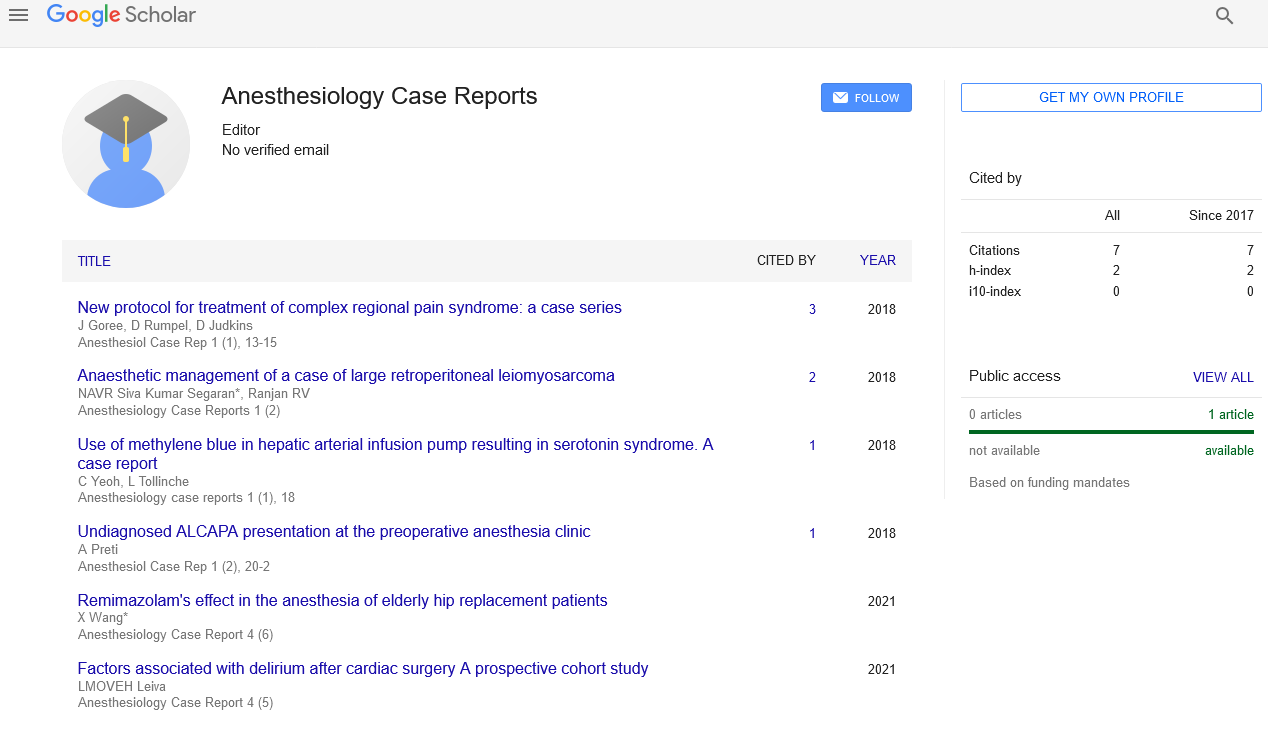COVID-19 generation of novel issues for pediatric anesthesia
Received: 15-Nov-2022, Manuscript No. PULACR-22-6459 ; Editor assigned: 20-Nov-2022, Pre QC No. PULACR-22-6459 (PQ); Accepted Date: Dec 09, 2022; Reviewed: 30-Nov-2022 QC No. PULACR-22-6459 (Q); Revised: 03-Dec-2022, Manuscript No. PULACR-22-6459 (R) ; Published: 11-Dec-2022
Citation: Pandey A. COVID-19 generation of novel issues for pediatric anesthesia. Anesthesiol Case Rep. 2022; 5(6)28-29
This open-access article is distributed under the terms of the Creative Commons Attribution Non-Commercial License (CC BY-NC) (http://creativecommons.org/licenses/by-nc/4.0/), which permits reuse, distribution and reproduction of the article, provided that the original work is properly cited and the reuse is restricted to noncommercial purposes. For commercial reuse, contact reprints@pulsus.com
Abstract
Coronavirus disease 2019 (COVID-19) has had an impact on anaesthetic care around the world, especially paediatric anaesthesia. Hospitals have weighed the dangers of a rise of resource-intensive COVID-19 patients against the possible morbidity of postponing elective surgical treatments. The unknown impact of COVID-19 on perioperative risk in disease-positive increases health care provider virus exposure. To reduce anxiety and the likelihood of crying with the subsequent aerosol generation, sedative premedication is indicated. If an intravenous sedation route is not available, other options (oral or intranasal) may necessitate a careful assessment of risks and benefits. Intranasal delivery has been discouraged due to concerns of induced coughing, despite the fact that this consequence is rare. It's worth noting that bitter-tasting oral solutions containing midazolam can cause spitting, coughing, and sobbing. The common practise of using paediatric patients complicates these decisions(1). We searched the MEDLINE inhalational inductions in children who do not have intravenous access is a database for papers involving COVID-19-positive paediatric patients who received general anaesthesia. A total of eight papers satisfied the criteria for inclusion, and they described a total of 20 cases (2). Preoperative COVID-19 symptoms were noted in nine patients, and one perioperative fatality was reported. Overall, further research is needed to expand the number of patients and accurately estimate the perioperative risk
Introduction
A Coronavirus disease 2019 (COVID-19) has had an impact on anaesthetic care around the world, especially paediatric anaesthesia. Hospitals have weighed the dangers of a rise of resourceintensive COVID-19 patients against the possible morbidity of postponing elective surgical treatments. The unknown impact of COVID-19 on perioperative risk in disease-positive increases health care provider virus exposure. To reduce anxiety and the likelihood of crying with the subsequent aerosol generation, sedative premedication is indicated. If an intravenous sedation route is not available, other options (oral or intranasal) may necessitate a careful assessment of risks and benefits. Intranasal delivery has been discouraged due to concerns of induced coughing, despite the fact that this consequence is rare. It's worth noting that bitter-tasting oral solutions containing midazolam can cause spitting, coughing, and sobbing. The common practise of using paediatric patients complicates these decisions[1]. We searched the MEDLINE inhalational inductions in children who do not have intravenous access is a database for papers involving COVID-19-positive paediatric patients who received general anaesthesia. A total of eight papers satisfied the criteria for inclusion, and they described a total of 20 cases [2]. Preoperative COVID-19 symptoms were noted in nine patients, and one perioperative fatality was reported. Overall, further research is needed to expand the number of patients and accurately estimate the perioperative risk [3-6].
During the early stages of the COVID-19 pandemic, worldwide, multicentre cohort research looked at adults who were diagnosed with COVID-19 between the ages of seven and thirty days after surgery. When the coronavirus illness 2019 (COVID-19) pandemic hit North America, most paediatric hospitals cancelled or postponed elective procedures in order to save healthcare resources for a expected surge of high-needs COVID-19 patients and prevents the disease from spreading in hospitals. Major perioperative outcomes included a staggering 23.8 percent death rate on postoperative day 30 and a 51.2 percent incidence of pulmonary problems, such as pneumonia and unexpected postoperative ventilation (5). Parental presence at induction is commonly utilised to minimise anxiety during anaesthesia induction in children; nevertheless, this practise increases the usage of Personal Protective Equipment (PPE) and likely special consideration for paediatric anaesthesia. Although an intravenous method may be recommended to reduce aerosol formation during induction, particularly in children at high risk for perioperative respiratory problems, the procedure of gaining intravenous access in children preoperatively may provoke screaming and generate aerosols and droplets. To reduce any exposure to employees in the room, a tight seal with the facemask and preventing significant gas fluxes may be useful [4-6].
Anaesthesia for the paediatric group during COVID-19 has its own set of issues. Despite the fact that the recorded incidence of sickness is lower in children, the high asymptomatic carrier rate raises the risk of viral transmission to other patients and care workers. With a reduced disease incidence, an integrated and realtime translation of knowledge and experience is more important to enable the safe delivery of critical patient care during an uncertain period. Until enough evidence emerges to advocate for specific initiatives in the optimal perioperative care for children during COVID-19, anesthesiologists should continue to apply their expertise to each pediatric patient, based on the patient's individual characteristics and the environment in which they practice anaesthesia.psychomotor and cognitive abilities to allow for early discharge.
References
- Ahmad F, Silva EL, Varesche MB. Hydrothermal processing of biomass for anaerobic digestion–a review. Renew. Sustain. Energy Rev. 2018;98:108-24.
- Al-Ashouri A, Köhnen E, Li B, et al. Monolithic perovskite/silicon tandem solar cell with> 29% efficiency by enhanced hole extraction. Science. 2020;370(6522):1300-9.
- Aruna-Devi R, Marasamy L, Cruz-Gómez J, et al. Exploring the performance of hybrid solar cells based on organic polymers/inorganic CdS nanostructures. Mater. Lett. 2021;282:128856.
- Aysu T, Durak H. Thermochemical conversion of Datura stramonium L. by supercritical liquefaction and pyrolysis processes. J. Supercrit. Fluids. 2015;102:98-114.
- Bach QV, Sillero MV, Tran KQ, et al. Fast hydrothermal liquefaction of a Norwegian macro-alga: screening tests. Algal Res. 2014;6:271-6.
- Baek SW, Jun S, Kim B, et al. Efficient hybrid colloidal quantum dot/organic solar cells mediated by near-infrared sensitizing small molecules. Nat. Energy. 2019;4(11):969-76.





